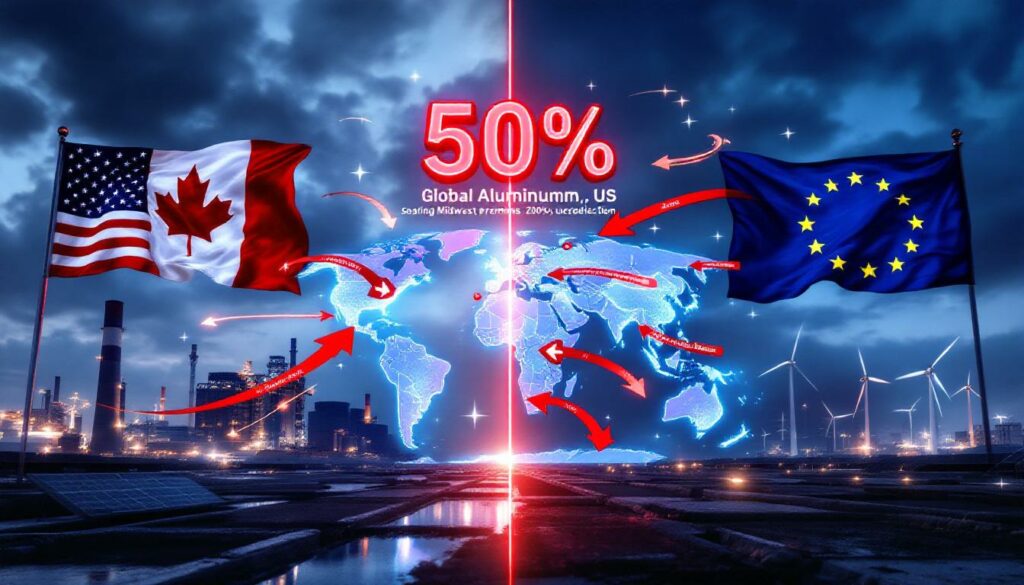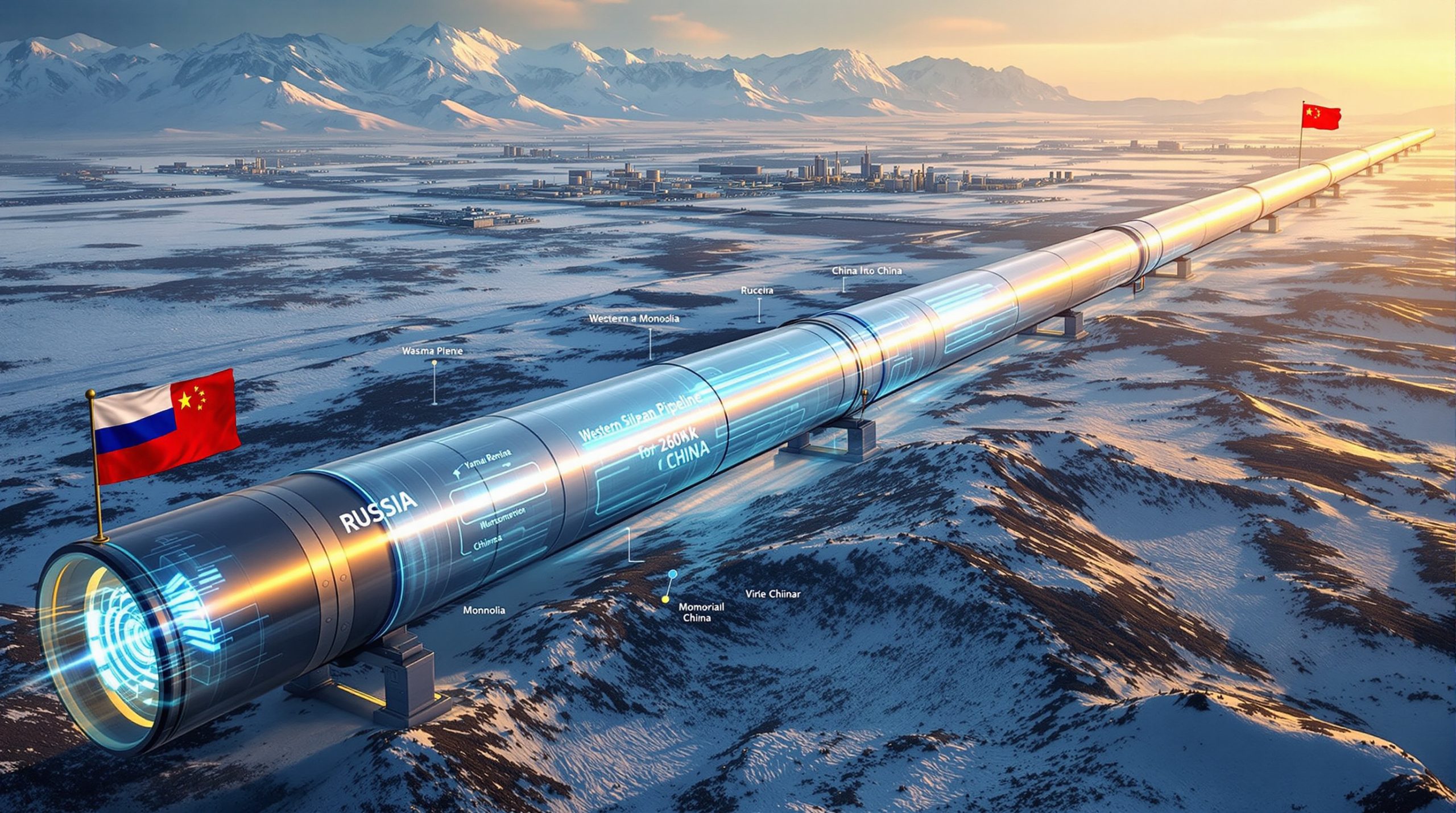Understanding the Impact of Recent US Tariff Policies
The dramatic escalation of Section 232 tariffs from 25% to 50% in June 2025 has fundamentally altered global aluminum trade flows, creating ripple effects throughout the industry. This policy shift has triggered unprecedented market responses as producers scramble to adapt their supply chains and optimize financial returns.
Massive Canadian Diversion Creates Supply Squeeze
In direct response to doubled tariffs, major producers like Alcoa have strategically redirected over 100,000 tonnes of Canadian aluminum away from traditional US destinations. As William Oplinger, Alcoa CEO, stated: "Where we have any ability to divert metal outside of the US… we will divert that either to Europe or to traders in Canada" (Fastmarkets, July 18, 2025).
This significant supply redirection has created an artificial shortage in the US market, driving the Midwest premium to historic heights. According to Fastmarkets' July 17, 2025 assessment, this key industry benchmark has surged to 68–70¢/lb, representing a staggering 200% increase since January 2025.
Economic Arbitrage Driving New Trade Patterns
Producers are now conducting sophisticated netback calculations—comparing potential returns across markets after accounting for tariffs, freight, and other costs—to determine optimal metal allocation. Current analyses overwhelmingly favor European destinations, with US tariffs on metals effectively nullifying traditional geographic advantages.
"We are not bringing metal from other parts of the world into the US… Right now, the netbacks suggest that we should be shipping into Europe, away from the US." – William Oplinger, Alcoa CEO (Fastmarkets, July 18, 2025)
Industry analysts project this redirection will intensify US supply constraints, potentially pushing the Midwest premium even higher as manufacturers compete for dwindling domestic supply.
How Are Major Producers Responding to Tariff Uncertainty?
Strategic Supply Chain Reengineering
Major aluminum producers with global operations have demonstrated remarkable flexibility in reallocating production flows to minimize tariff impact on markets. Companies with diversified assets can leverage their international footprint to optimize returns, creating complex new trade patterns that would have been economically irrational before the tariff increase.
Global Flows Redirected Based on Premium Differentials
With 2.2 million tonnes of annual production capacity (2024 figures), Alcoa exemplifies how producers can pivot operations in response to trade barriers. Rather than absorbing tariff costs, companies are systematically diverting metal to markets offering superior returns based on rigorous netback analyses.
This strategic redirection has created a cascading effect of supply adjustments across regions as producers continuously evaluate premium differentials between markets. Oplinger notes this situation may eventually self-correct: "But over time, as the US becomes very short [of] metal, the Midwest premium will react and remotivate us and others to ship back" (Fastmarkets, July 18, 2025).
Import Avoidance Strategies
Beyond redirecting Canadian production, companies have halted aluminum imports from other global assets into the US market. This comprehensive approach maximizes financial performance while adapting to the new trade reality, even as it exacerbates domestic supply constraints.
Financial Implications for Aluminum Producers
The tariff landscape has fundamentally altered capital allocation strategies across the industry, with companies adopting more conservative investment approaches while reassessing portfolio composition.
Investment Paralysis Amid Policy Uncertainty
Major producers have frozen significant capital deployment decisions until tariff permanence becomes clearer. As Oplinger candidly acknowledged: "We won't make long-term decisions based on short-term dynamics in a market, and right now, we need to see how long tariffs will be around" (Fastmarkets, July 18, 2025).
This hesitation particularly impacts potential US and Canadian capacity expansions, with previously viable projects now facing economic uncertainty.
Strategic Divestments and Portfolio Optimization
Uncertainty has accelerated strategic exits from non-core assets. Alcoa's July 2, 2025 divestiture of its 25.1% stake in the Ma'aden joint venture exemplifies this trend, with Oplinger noting: "There is no plan around growth currently in the Persian Gulf region" and adding that the joint venture's value wasn't adequately reflected in Alcoa's stock price.
Simultaneously, the company has prioritized corporate simplification, as evidenced by its $2.8 billion acquisition of Alumina Ltd, which streamlined operations and eliminated organizational complexity.
Share Price Volatility
Market capitalization across the aluminum sector has experienced significant fluctuations as investors attempt to price in tariff impacts. Companies with flexible global operations have generally outperformed those with concentrated US exposure.
What Are the Structural Challenges for US Aluminum Production?
Energy Economics vs. Tariff Protection
Despite the protective intent of increased tariffs, fundamental economic realities continue to limit US aluminum production capacity expansion. The most significant barrier remains energy costs, which typically represent 30-40% of smelting expenses.
The Critical $30/MWh Threshold
Industry experts consistently identify $30/MWh as the maximum viable energy cost for competitive US smelting operations. However, this target remains elusive in most US regions, with current industrial electricity rates significantly exceeding this threshold.
Competition from Data Centers
The aluminum industry faces intensifying competition for affordable energy from higher-margin sectors. As Oplinger observed: "Data centers are willing to pay triple what an aluminum smelter would pay for energy. That puts pressure on reshoring aluminum capacity" (Fastmarkets, July 18, 2025).
This economic reality creates a bidding war for power resources that aluminum producers cannot win, regardless of tariff protection. The rapid expansion of AI computing centers has further intensified this disadvantage, with technology companies securing long-term power contracts at premium rates.
Renewable Energy Requirements
Modern aluminum production increasingly demands access to low-carbon electricity, both for cost stability and sustainability credentials. Oplinger emphasized that any potential US investment would require "an advantaged power position" (Fastmarkets, July 18, 2025), highlighting the inseparable connection between energy availability and production viability.
Supply Chain Constraints
Beyond energy challenges, the US faces significant structural limitations throughout the aluminum value chain that tariffs alone cannot overcome.
Raw Material Limitations
US aluminum production is hampered by limited domestic access to essential inputs:
- Bauxite: Nearly all bauxite must be imported, creating supply chain vulnerability
- Alumina: US refining capacity satisfies less than 25% of potential smelting needs
These upstream constraints make fully integrated US production challenging, regardless of tariff levels.
Infrastructure Requirements
Establishing new smelting capacity represents a massive capital commitment requiring:
- 5-7 years for greenfield development
- $2+ billion investment per facility
- Extensive supporting infrastructure
Oplinger noted that "reshoring aluminum production is a long, capital- and energy-intensive process" (Fastmarkets, July 18, 2025), underscoring why tariffs alone cannot rapidly expand domestic capacity.
How Is the Global Aluminum Market Adapting?
Market Tightness and Price Implications
The redirection of aluminum flows has created significant price dislocations across regions, with the US market experiencing particular tightness as supplies diminish.
Premium Escalation Dynamics
The Midwest premium's surge to 68-70 cents per pound represents only the beginning of potential price escalation. As Oplinger warned: "Ultimately, all things [being] equal, the Midwest premium will go even higher, based on the fact that the US will become shorter on metal" (Fastmarkets, July 18, 2025).
This premium increase directly impacts US manufacturers, raising total aluminum costs significantly above global benchmark prices.
Supply-Demand Imbalance Projections
Analysts project widening US market deficits as producers continue optimizing netbacks across regions. The 100,000+ tonnes already diverted by Alcoa alone represents just the initial response, with further reallocation likely if tariffs persist.
This growing imbalance will eventually create sufficient economic incentive—through elevated premiums—to overcome tariff barriers and attract imports despite the 50% duty.
Global Flow Redirections
The aluminum industry is witnessing unprecedented shifts in traditional trade patterns:
- Canadian metal flowing to Europe instead of the US
- European consumers securing additional tonnage
- US buyers facing increased competition for diminishing supply
These adjustments demonstrate the market's remarkable adaptability in responding to trade barriers, often in ways that undermine policy objectives.
Industry Policy Recommendations
Leading producers advocate for structural trade policy reforms to address market distortions while maintaining appropriate protections.
North American Trade Architecture
Oplinger has proposed a coordinated US-Canada approach: "If the US and Canadian governments feel the need to have tariffs on aluminum, there should be a coordinated trade wall that sits outside – at the border of North America – and allows metal to flow from Canada to the US without tariffs" (Fastmarkets, July 18, 2025).
This recommendation recognizes the deeply integrated nature of North American aluminum production and the counterproductive effects of intra-continental barriers.
Long-term Energy Solutions
Industry experts emphasize that sustainable US aluminum production requires comprehensive energy transition challenges, including:
- Incentives for renewable energy development in aluminum-producing regions
- Infrastructure investment to deliver affordable power to production facilities
- Recognition of aluminum's role in clean energy transition
Without addressing these fundamental challenges, tariff protection alone will prove ineffective in stimulating domestic capacity expansion.
What's the Future of Low-Carbon Aluminum Production?
Technological Innovations Transforming the Industry
Despite market disruptions, the aluminum industry continues advancing revolutionary production technologies that could fundamentally alter its environmental footprint.
Elysis Technology Deployment Timeline
The groundbreaking Elysis joint venture—a partnership between Alcoa, Rio Tinto, Apple, and Canadian governments—is progressing toward commercial carbon-free aluminum production. As Oplinger confirmed: "The smaller cell we built has operated for long periods and produced high-quality P1020 metal" and "a commercial-scale cell is on track to be operational in 2025" (Fastmarkets, July 18, 2025).
This technology represents a paradigm shift in aluminum production, eliminating direct carbon emissions from the smelting process.
Inert Anode Advancement
The revolutionary aspect of Elysis technology lies in replacing traditional carbon anodes with inert alternatives that don't consume carbon during electrolysis. This innovation:
- Eliminates direct CO₂ emissions from the smelting process
- Produces oxygen as a byproduct instead of carbon dioxide
- Reduces the overall carbon footprint by 50-70%
These advancements position North American producers at the forefront of low-carbon aluminum innovation, potentially creating competitive advantages that transcend tariff considerations.
Collaborative Innovation Models
The Elysis project demonstrates the power of public-private partnerships in addressing industry challenges. By combining corporate R&D capabilities with government support, the partnership has accelerated technology development despite market uncertainties.
Market Demand for Sustainable Aluminum
Consumer preferences increasingly influence production decisions, with low-carbon aluminum commanding growing premium in key markets.
Premium Pricing for Green Metal
Sustainability credentials are creating meaningful market differentiation, with manufacturers willing to pay premiums for low-carbon aluminum. Products like Alcoa's EcoLum™ attract premium pricing based on verified carbon intensity metrics.
Customer Partnerships
The extension of Alcoa's supply agreement with European cable manufacturer Prysmian demonstrates growing demand for verified low-carbon aluminum (Fastmarkets, July 18, 2025). Similar partnerships are emerging across industries, from automotive to packaging, as manufacturers seek to reduce scope 3 emissions.
Certification Standards Evolution
The market continues developing frameworks for defining and verifying low-carbon aluminum, including:
- The Aluminum Stewardship Initiative (ASI) certification
- Producer-specific carbon intensity declarations
- Customer-mandated sustainability requirements
These evolving standards create transparency and enable price differentiation based on environmental performance.
How Are Capital Allocation Strategies Evolving?
Strategic Investment Priorities
The combination of tariff uncertainty and market volatility has fundamentally altered how aluminum producers allocate capital, with risk mitigation taking precedence over aggressive expansion.
Deleveraging Focus
Financial resilience has become the industry's top priority in uncertain market conditions. As Oplinger emphasized: "We believe that the best way to create value for our shareholders is by getting to an optimal capital structure" (Fastmarkets, July 18, 2025).
This conservative approach prioritizes debt reduction and balance sheet strengthening over aggressive capacity expansion, reflecting concerns about market volatility and policy uncertainty.
Incremental Growth Projects
Rather than major greenfield investments, producers are pursuing targeted expansions of existing operations. Examples include:
- Production "creep" initiatives that increase output through operational efficiency
- Cast house upgrades to enhance product capabilities
- Focused brownfield expansions in regions with favorable economics
These incremental approaches minimize capital exposure while maintaining growth trajectories.
Value-Based Acquisition Criteria
Merger and acquisition activity increasingly focuses on operational synergies and portfolio optimization rather than pure capacity growth. Alcoa's $2.8 billion Alumina Ltd acquisition exemplifies this approach, simplifying corporate structure and unlocking operational efficiencies.
Regional Investment Considerations
Tariffs have fundamentally altered the attractiveness of different regions for aluminum investment, creating new patterns of capital allocation.
Quebec Expansion Reconsideration
Previously advantaged by low-cost renewable hydropower, Canadian operations now face uncertainty due to tariff exposure. As Oplinger noted: "With the tariffs in place, Quebec becomes that much less competitive" (Fastmarkets, July 18, 2025).
This reassessment demonstrates how trade policies can undermine natural competitive advantages and distort investment decisions.
Strategic Divestments
Producers are exiting non-strategic assets to focus capital on core operations. Alcoa's July 2, 2025 divestiture of its 25.1% stake in the Ma'aden joint venture reflects this portfolio optimization approach, with proceeds redirected toward debt reduction and higher-return opportunities.
Cast House Upgrades in Europe
With European markets becoming more attractive due to tariff differentials, producers are directing capital toward downstream facilities serving these regions. These targeted investments enhance product capabilities while minimizing exposure to volatile commodity markets.
What Does This Mean for Global Aluminum Markets?
Short-Term Market Implications
The aluminum industry faces a period of significant adjustment as trade flows reorganize in response to tariff barriers.
Price Volatility Expectations
Market participants should prepare for continued price uncertainty as supply chains adjust to new trade realities. The Midwest premium's 200% increase since January 2025 illustrates the magnitude of potential volatility.
Oplinger's prediction that "the Midwest premium will go even higher" (Fastmarkets, July 18, 2025) suggests further turbulence ahead, particularly for US consumers.
Regional Premium Divergence
The gap between US and other market premiums will likely widen further as tariffs continue distorting trade flows. This divergence creates:
- Arbitrage opportunities for traders
- Cost disadvantages for US manufacturers
- Complex hedging challenges for market participants
These regional disparities potentially undermine the competitiveness of downstream US aluminum consumers in global markets.
Supply Chain Adaptation Costs
Rerouting aluminum flows imposes significant financial burdens throughout the supply chain:
- Increased logistics costs from suboptimal transportation routes
- Inventory management challenges due to longer lead times
- Contract renegotiation expenses amid changing market conditions
These adaptation costs ultimately impact end-user pricing and industry competitiveness.
Long-Term Industry Transformation
Beyond immediate disruptions, current trade policies may trigger fundamental structural changes in global aluminum markets.
Reshaping of Traditional Trade Patterns
As supply chains adapt to persistent tariff barriers, many redirected metal flows will become permanent fixtures in the global market. These adjustments create new commercial relationships and logistics patterns that may persist even if tariffs eventually decrease.
Investment in Domestic Processing
While primary aluminum production remains challenging in the US due to energy constraints, downstream fabrication could see increased investment as manufacturers seek to minimize tariff exposure on value-added products.
Acceleration of Low-Carbon Technologies
Trade disruption may paradoxically accelerate decarbonisation benefits as producers seek competitive advantages beyond price. Technologies like Elysis represent potential game-changers that could reshape competitive dynamics regardless of tariff environments.
FAQs About US Aluminum Tariffs and Market Impacts
What caused the recent spike in US aluminum premiums?
The doubling of Section 232 tariffs from 25% to 50% in June 2025, combined with producers diverting Canadian metal away from the US market, has created supply tightness reflected in premiums rising over 200% since early 2025.
Will tariffs succeed in reshoring aluminum production to the US?
Industry experts indicate that tariffs alone are insufficient, as energy costs remain the primary barrier. For new US smelting to be viable, energy prices would need to fall to approximately $30 per MWh, with renewable energy availability being a critical factor.
How are aluminum producers adapting their supply chains?
Major producers are rerouting metal flows
Looking to Stay Ahead of Major Mineral Discoveries?
Discover significant ASX mineral discoveries as they happen with Discovery Alert's proprietary Discovery IQ model, delivering real-time notifications that can lead to actionable trading opportunities before the broader market responds. Explore historic examples of exceptional investment returns on our discoveries page and position yourself for success.




